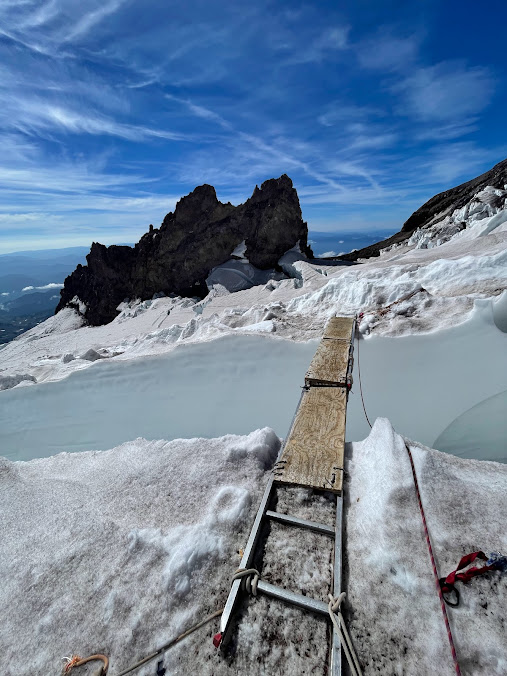The 17,000+ foot freezing levels we've had over the last few days have had quite the impact on Mount Rainier and its glaciers. Things have been changing drastically from one day to the next (or hour by hour) with how fast things are melting. This puts climbers at a higher level of risk than normal and requires a lot of prior experience on glaciers and climbing to have the skillset for managing the risks and route navigation decisions. Again, these HOT temperatures are making conditions DIFFICULT for climbers.
The traverse across the Cowlitz Glacier has been changing day by day as guide groups have made edits to the route as crevasses rapidly open up in the bootpack and rockfall threats above change fall lines. A number of people have punched into some crevasses, surprised to fine the "track" went over an overhanging snow bridge that was not obvious before. No climber "plans" on falling in a crevasse, so please come prepared on these HOT days to do actual crevasse rescue.
The double ladder at high crack at the moment is still in place and folks can still traverse onto the Cleaver, but the plug that connects to the cleaver had water running underneath it and has a big overhang, so if it were to collapse in these HOT temperatures it would not be good.
 |
| Looking at the traverse onto the DC on 8/14/2023 |
Above the cleaver, the snow is isothermic, or "punchy" and not very supportable. There have been reports of folks falling into crevasses unexpectedly here too. The double ladder at 12,800' was still in place as of August 16th, but from here, folks can plan on finding their own route. On August 15th, the guides pulled the triple ladder spanning the 12,900' crack because it was sitting on overhangs that weren't reliable. No parties have summited the DC Route for the last couple of days due to crevasses not being safe to cross.
 |
| Upper Thousand plus feet of the DC Route. 8/14/2023 |
Parties that want to find their way to the summit via the DC Route will have to do some extreme end-running of crevasses or rappel into and ascend out of crevasses. And, at the moment, you will need to find your own route, accept a relatively high level of risk for this route, and have extensive glacier and climbing experience. Recognize that crevasses may fail any time during the day, sometimes behind you, leaving your party to discover they can't descend via the route they came up.
 |
| Another view of the upper couple thousand feet of the mountain. 8/14/2023 |
Luckily there is an end to this heat in sight. Temperatures look like they may plummet to about 9000' freezing levels by Sunday. After these warm temperatures however, such cold conditions will likely present challenging conditions in a different way - all this glacial melt could solidify making for icy and unforgiving surfaces. Having sharp, steel crampons on full shank boots and sure footing with them will be essential to help you manage this upcoming drastic change in conditions.
 |
| Looking at Camp Schurman and the Emmons-Winthrop on 8/14/23 |
While this all sounds a bit dire, there's still some great vistas, cooler temps, and great opportunities to practice mountaineering skills around both high camps on the mountain. The stars and meteor showers have been all-time. Just don't plan on a typical "summit climb" adventure right now. See you on the mountain!
 |
| Looking above the Cleaver. 8/14/23 |
 |
| View near the Emmons shoulder and the 12,900 crack. 8/14/23 |















































